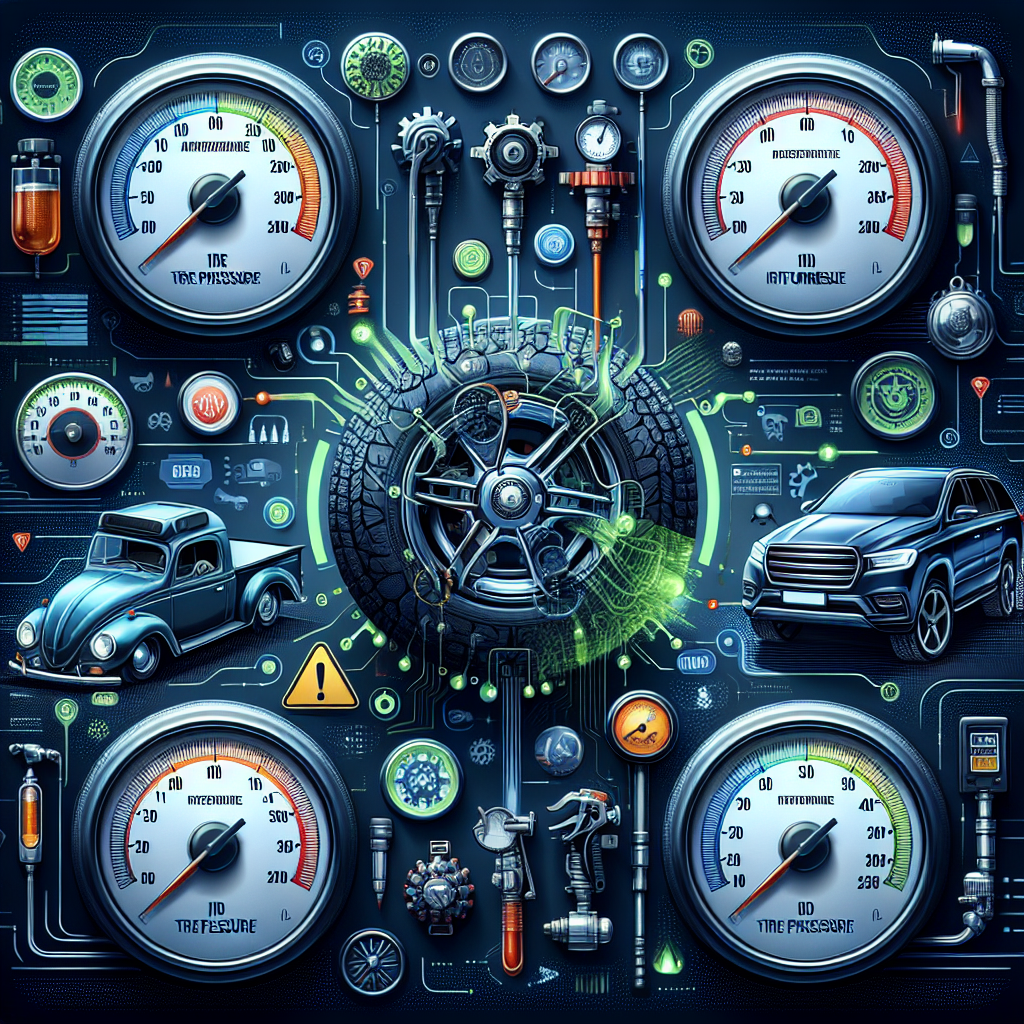Have you ever wondered what the optimal tire pressure is for your vehicle? Maintaining the correct tire pressure not only ensures a smooth and comfortable ride, but it also maximizes fuel efficiency and enhances overall safety. In this article, we will explore the importance of tire pressure and provide you with the necessary information to determine the recommended tire pressure for your specific vehicle. So, sit back, relax, and let’s dive into the world of tire pressure!
Importance of Proper Tire Pressure
Proper tire pressure is essential for maintaining safety on the road, enhancing fuel efficiency, and maximizing the lifespan of your tires. It may seem like a small detail, but it has significant effects on your overall driving experience. By understanding the importance of maintaining the correct tire pressure, you can ensure a smooth and safe journey every time.
Improves Safety
One of the most critical reasons to maintain proper tire pressure is safety. When your tires are inflated to the recommended level, they have better traction and grip on the road, especially during turns and sudden maneuvers. This improves your vehicle’s stability and reduces the risk of accidents or skidding. Underinflated tires, on the other hand, can lead to poor handling, decreased braking performance, and an increased risk of blowouts.
Enhances Fuel Efficiency
Proper tire pressure can have a significant impact on your vehicle’s fuel efficiency. When your tires are correctly inflated, they roll more smoothly and with less resistance. This means that your engine has to work less to move the vehicle, resulting in improved fuel consumption. On the other hand, underinflated or overinflated tires can cause increased rolling resistance, which leads to higher fuel consumption and unnecessary expenses at the pump.
Maximizes Tire Life
Maintaining the proper tire pressure can also help extend the lifespan of your tires. When your tires are inflated correctly, the weight of the vehicle is distributed evenly across the tire surface. This ensures that the tread wears out evenly and prevents premature and uneven tire wear. By maximizing tire life, you not only save money by avoiding frequent tire replacements but also ensure optimal performance and safety on the road.
How to Determine the Proper Tire Pressure
Determining the correct tire pressure for your vehicle is essential for ensuring optimal performance and safety. There are a few methods you can use to find the recommended tire pressure:
Refer to the Owner’s Manual
The first and most reliable source of information for your vehicle’s recommended tire pressure is the owner’s manual. It provides accurate and specific details for your particular vehicle make and model. The owner’s manual will usually include the recommended tire pressure for different driving conditions, such as normal driving or carrying a heavy load.
Check the Tire Placard
Another way to determine the proper tire pressure is by checking the tire placard. The tire placard is a label typically located on the driver’s side door jamb or inside the glove compartment. It displays important information, including the recommended tire pressure, tire size, and load-carrying capacity. Ensure that you use the recommended pressure specified on the placard for the best results.
Consult a Tire Professional
If you’re unsure about the recommended tire pressure or unable to find the information through the owner’s manual or tire placard, it’s best to consult a tire professional. Tire professionals have the expertise and knowledge to recommend the correct tire pressure based on your vehicle’s specifications. They can also provide valuable advice on any specific considerations or changes related to your tires.

Factors Affecting Tire Pressure
Several factors can affect tire pressure, and it’s essential to understand them to maintain optimal performance and safety. The following factors should be taken into account:
Temperature Changes
Temperature changes can significantly impact tire pressure. As the temperature rises, the air inside the tire expands, leading to an increase in tire pressure. Conversely, when the temperature drops, the air contracts, reducing the tire pressure. It’s important to regularly check and adjust tire pressure with temperature fluctuations to ensure it remains within the recommended range.
Load and Weight Distribution
The load and weight distribution of your vehicle can affect tire pressure. Carrying heavy loads or unevenly distributing weight can lead to increased pressure on certain tires, causing them to wear out faster or become overinflated. It’s crucial to follow the manufacturer’s guidelines for load capacity and weight distribution to maintain proper tire pressure and prevent uneven tire wear.
Driving Conditions
The driving conditions you encounter can also impact tire pressure. Off-road driving, driving on rough terrains, or hitting potholes can cause tire pressure to decrease due to leaks or damage. It’s important to regularly inspect your tires for any signs of damage and monitor tire pressure after driving in challenging conditions. Adjusting the tire pressure accordingly will help ensure your tires remain in optimal condition.
Understanding Tire Pressure Ratings
To make informed decisions about tire pressure, it’s crucial to understand different tire pressure ratings. These ratings provide valuable information about how to properly inflate your tires:
Maximum Tire Pressure
Every tire has a maximum tire pressure rating, which indicates the highest pressure it can withstand safely. It’s important never to exceed this maximum pressure limit, as it can lead to tire damage or blowouts. The maximum tire pressure rating is typically imprinted on the tire sidewall and should be referenced if you’re unsure about the limits for your specific tires.
Recommended Tire Pressure
The recommended tire pressure is the pressure level recommended by the vehicle manufacturer for the specific make and model. This recommended pressure takes into account various factors, such as vehicle weight, tire size, and driving conditions. Following the recommended tire pressure ensures optimal performance, safety, and tire longevity.
Tire Pressure Monitoring System
Many modern vehicles are equipped with a Tire Pressure Monitoring System (TPMS), which alerts drivers when tire pressure is too low. TPMS uses sensors to monitor tire pressure and provides real-time information to the driver through a dashboard display or warning light. It’s important to understand and regularly check the TPMS to ensure your tires are properly inflated and avoid potential issues caused by underinflation.

Why Overinflating Tires is Problematic
While maintaining the proper tire pressure is crucial, overinflating tires can also lead to various problems that negatively affect your driving experience and safety. Here are some consequences of overinflating tires:
Uneven Tire Wear
Overinflated tires tend to wear unevenly, primarily due to the reduced contact area with the road. The center of the tire tread wears out faster than the edges, leading to a “center wear” pattern. Uneven tire wear not only decreases the lifespan of your tires but also negatively affects handling and traction, making your vehicle more prone to skidding or hydroplaning.
Reduced Traction
Overinflated tires have a smaller contact patch with the road, reducing traction and grip. This can negatively affect braking performance, especially in wet or slippery conditions. Reduced traction increases the risk of accidents, particularly when trying to stop suddenly or maneuver through sharp turns.
Rough Ride
Overinflated tires can lead to a rough and uncomfortable ride. The increased stiffness of the tires reduces their ability to absorb shocks and vibrations from the road. This can make your driving experience less comfortable and increase fatigue during long journeys.
Consequences of Underinflating Tires
While overinflating tires is problematic, underinflating them can also have severe consequences on your vehicle’s performance and safety. Here are some potential consequences of underinflating tires:
Decreased Fuel Efficiency
Underinflated tires create more rolling resistance and require more effort from the engine to move the vehicle forward. This extra effort translates into increased fuel consumption and decreased fuel efficiency. Over time, the additional fuel costs can add up significantly.
Poor Handling and Control
Underinflated tires have reduced responsiveness and compromised handling. They can feel “squishy” or sluggish, affecting your ability to control the vehicle precisely. Poor handling and control can be particularly dangerous in emergency situations where quick and accurate maneuvers are necessary.
Increased Risk of Blowouts
Underinflating tires puts additional stress on the tire’s sidewalls, making them more susceptible to failure. This can lead to blowouts, especially at high speeds or when driving on rough roads. Blowouts are not only dangerous but can also cause extensive damage to your vehicle.

The Influence of Tire Type on Pressure
Different tire types have varying pressure requirements to ensure optimal performance and safety. Understanding the recommended pressure for each tire type is crucial. Here are some considerations for different tire types:
Different Tire Types
Tire types can vary based on their intended use. Some common tire types include all-season tires, summer tires, performance tires, and winter tires. Each tire type is designed to perform best under specific conditions, and they may have different pressure recommendations to match their unique characteristics.
Recommended Pressure for Each Type
To determine the recommended tire pressure for each tire type, it is essential to refer to the manufacturer’s guidelines specific to that tire. The recommended pressure may differ due to variations in tread design, rubber composition, and intended use. Consulting the tire manufacturer’s recommendations ensures optimal performance and safety based on the tire type you are using.
Considerations for Winter Tires
Winter tires are specifically designed for cold weather conditions and provide improved traction on snow and ice. When it comes to winter tires, it’s important to follow the manufacturer’s recommended tire pressure, as lower pressures may be needed to enhance grip in snowy or icy conditions. Be sure to adjust the tire pressure accordingly when transitioning between winter and other tire types.
How to Properly Inflate Your Tires
Properly inflating your tires is essential for maintaining performance, safety, and longevity. Follow these steps to ensure your tires are inflated correctly:
Use a Reliable Tire Pressure Gauge
Invest in a good quality tire pressure gauge to ensure accurate readings. Cheap or unreliable gauges may provide inaccurate measurements, leading to improper tire inflation. A digital gauge or a manual gauge with a clear display is recommended for ease of use.
Locate the Valve Stem
Locate the valve stem on one of the tire sidewalls. The valve stem is a small circular protrusion where you inflate and deflate the tire. Remove the valve stem cap and keep it in a safe place while inflating.
Add or Release Air as Needed
Using the tire pressure gauge, check the current tire pressure. Compare it to the recommended pressure listed in the owner’s manual or on the tire placard. If the pressure is too low, attach the air hose to the valve stem and add air until the desired pressure is reached. If the pressure is too high, carefully release air by pressing the small pin inside the valve stem.
Continue this process for each tire, ensuring that all tires are inflated evenly and to the correct pressure level.

Regular Tire Pressure Maintenance
Maintaining proper tire pressure is an ongoing process that requires regular attention and monitoring. Follow these maintenance tips to ensure your tires are in optimal condition:
Check Tire Pressure Monthly
It’s recommended to check your tire pressure at least once a month, even if you don’t notice any visible problems. Regularly monitoring your tire pressure allows you to catch any gradual decreases or abnormalities before they lead to more significant issues.
Perform Checks After Long Trips
After long trips or when carrying heavy loads, it’s crucial to check your tire pressure. These factors can increase the stress on your tires, leading to potential changes in pressure. Checking and adjusting the tire pressure after these situations ensures your tires are properly inflated for optimal performance and safety.
Monitor Tire Pressure During Extreme Weather
Extreme weather conditions, such as extreme heat or cold, can affect tire pressure more significantly. During periods of extreme weather, monitor your tire pressure more frequently and make adjustments as necessary. This will help compensate for the thermal expansion or contraction of the air inside your tires.
Final Thoughts on Tire Pressure
Maintaining the recommended tire pressure is crucial for your vehicle’s safety, fuel efficiency, and tire longevity. It’s important to consult the owner’s manual, tire placard, or a tire professional to determine the appropriate tire pressure for your specific vehicle. By adhering to these recommendations and considering additional factors such as temperature changes, load and weight distribution, and driving conditions, you can ensure optimal tire performance and a comfortable driving experience. Regular monitoring and maintenance of tire pressure will not only enhance your safety but also save you money in the long run by maximizing fuel efficiency and extending the lifespan of your tires.


